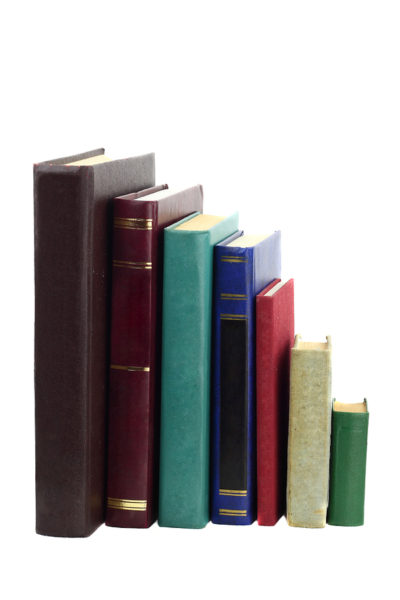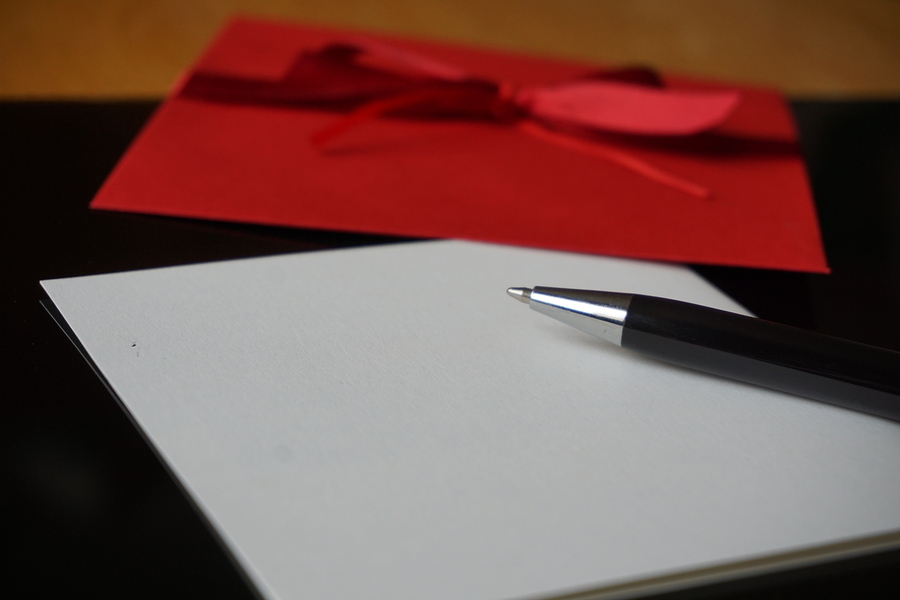Trim size is one of those terms we use frequently when talking about the dimensions of your printed book.
The term comes from the fact that during the printing process the pages of the book first printed on large sheets which are folded, glued, and later “trimmed” to a specific size. (This linked video shows the entire book printing process.) Go to your shelf and pull down a few titles and measure the page dimensions to see a physical example of what is described below.
There aren’t any hard and fast “rules” about what size a book should be. It is determined by many factors, almost too numerous to explain. But there are some general guidelines and terms.
Below I’ll list the publisher jargon that describes this particular trim size. Then will be the dimensions of that book. The first number is the short side measurement the second number is the tall or long-side measurement. This is the measurement of the paper. A hardcover book has a cover that is a little bit larger than the trim size of the paper.
Mass Market – 4-1/4” x 7”
These are the ones you might see in the grocery store checkout line or in an airport store. Years ago special racks and shelves were built specifically for this size. It suggested an inexpensive version of a book. Most often this is used in the fiction category.
Recently this trim size has been affected by the rise of ebooks. Fewer titles are done in mass market.
Book contracts often have a separate royalty rate for this trim size since the retail price is lower and in many cases the book can be returned to the publisher by simply tearing the cover off and returning that stripped book cover. It is called “Strip Cover Returns.”
Trade Paperback – ranges from 5-1/2” x 8 1/2″ to 6” x 9”
This is the go-to trim size for most paperbacks in today’s market. Fiction tends toward the 5 1/2” x 8 1/2″ size, but not always.
This 5.5” x 8.5” size is also efficient because it is the dimension of a regular piece of paper folded in half.
The larger 6” x 9” for some publishers is the default for textbooks or certain types of non-fiction.
There are times were the larger trim size is an advantage because there is more “real estate” for the content to fit. Thus you can keep the content the same but use fewer pages to print, which costs less money. There is a minor difference in cost between 6×9 and 5.5×8.5.
Manuals or Workbooks – 8 1/2″ x 11”
This is a common trim size because each page is like a regular sheet of paper. The only problem for this is in a brick-and-mortar store. Bookstore shelves are only 10 inches high. Thus workbooks are either placed on their side in the shelf or stuck on the top corner; making them hard to find later.
A number of smart publisher realized this and use a 7” x 9” trim size for work books.
Other Trim Sizes
I can hear you saying “But I have book that are very different from any of these mentioned!” There are no rules per se. Gift books, Children’s books, devotionals, etc can take almost any form. For example, I have a Bible Timeline book in my office that is 17 1/2″ x 14” with fold out pages.
The only limitation is the creativity of the publisher!
Who Decides the Trim Size?
Early in the publishing process the acquisitions editor talks to marketing and sales to discuss trim size, especially if something a little different than normal will be used.
In my days at Bethany House I experimented with non-fiction books printed using a 6” x 8 1/2″. We had been told that 6×9 would not work with the racks in grocery stores and airport spin racks. So we “trimmed” a half inch off the long side and they fit! We were able to place a number of significant non-fiction titles in those racks because of that trim size choice.
Your Turn:
Share with us the trim size mix of books on one of the shelves in your library. Are they mostly 5.5 x 8.5 trade paperback? Or something else?





As a retailer with a lot of inventory in a small space, this topic really matters to me. We do have some non-variable shelving where the 6 x 9 size is problematic; and we have to watch committing space to mass markets with their lower retail pricing.
But more to the point, oddly trimmed and oversize books tend to get lost in the shuffle in our store. They stand out from the crowd (that’s good) but they don’t get to share space with others in the same genre or category (not good). Writers and publishers need to think this through carefully. Unless the book is really crying for oversize treatment, conformity might be the wiser choice.
I Just measured a stack of my most-recent reads and found they are 6 by 9. How interesting- I never noticed the size before. One thing about the video’s information on the gluing together of the books: I wonder if academic books are stuck together with inferior glue because I had several fall apart on me when I was an undergrad….for what we paid for them, that shouldn’t have happened!
From the “or something else” category:
I have well over 500 books, 99.999 percent are hardcover. Some of the more interesting sizes are 15.25 x 11 x 2.5 thick coming in at just over 11 lbs. titled “The Complete Works of Raphael” an Artabras book from Harrison House publishers N.Y. copyright 1989.
One of the odd sizes that I would not part with came from an auction at a courthouse that was remodeled in the Midwest. It is 9.25 x 13 x 4 thick. It is Websters Third New International Edition Dictionary copyright 1966. When holding it you can almost feel the bit part it played in many court cases, some of them capital.
I used to go to book shopping on weekend afternoons looking for gems. I would many times spend more than intended (this is when a quality art book could cost well over a hundred dollars EACH). Another aspect of my collection are books from old that contained highly valid information (such as techniques of the old master painters) that has been lost to todays generations.
The internet brought my book accumulating days to a practical end, there is no longer any need, at least for me, to have hard copies. I will likely donate my collection somewhere worthy when the time comes. Looking not that far into the future some bright and inquisitive young person might actually be heard saying, “Did the primitives really go to all that trouble to put, what did you call it, oh yeah, ink, onto paper sheets and sew or glue it all together. Crazy man!”
A number one hit in the U.K. and U.S.A. from 1969.
https://www.youtube.com/watch?v=N03Uoj6p9QA
I wouldn’t count print out at all. It will probably be around longer than the electronic formats we’re using now. One good burst of electromagnetic radiation (EMP), and our electronics will fry, but we’ll still be able to read print by firelight.
My son (22) and one of the other college-age guys (19) at my church are rabid readers (as in usually have a book with them), and they both read almost exclusively hardcopy. My daughter (21) reads more hardcopy than ebook as well. The reports that millennials prefer hardcopy to electronic is what I observe myself.
Watching that video provided insight that would be called up later. Thank you for sharing Steve.
The “strip cover returns” link and the video about how the printer builds an entire book were nicely informative. Thanks!
Steve, what is the approximate conversion factor for the reduction in the number of pages if you convert a 5-1/2” x 8 1/2″ to a 6” x 9″ format?
If the reduction in number of pages leads to savings, why would a publisher choose 5 1/2 x 8 1/2?
The smaller size is chosen for esthetic and market reasons. Fiction tends to be the smaller trim size. But there isn’t necessarily a rule.
I just bought a nonfiction book at an airport that was 5.5 x 8.5. It may be that the hard cover edition was that same size, so the publisher did not have to retypeset the pages.
It all comes down to what the publisher thinks will sell best.
Hi, I would just like to ask does this mean a trim size of 5 x 8 inches will be the outside size of the finished paperback book, but if it was hardcover it would be slightly larger?
Only measure the printed page. Not the cover.
A hard cover is always a little larger, but the paper itself is printed the correct size.
Go to your shelf right now and try it out. Take down a 6×9 paperback and measure the edges of the paper.
Then take down a hardback and measure ONLY the paper. Not the binding materials or even the glue. Just the paper.